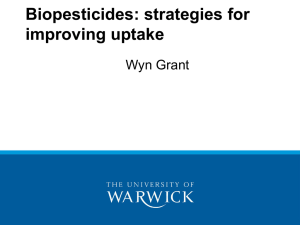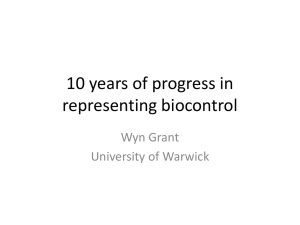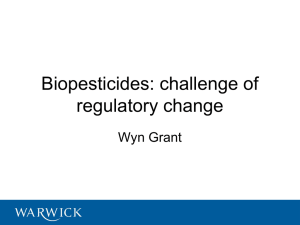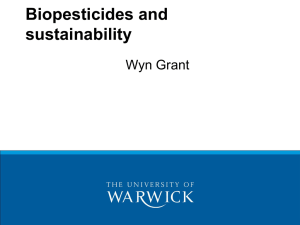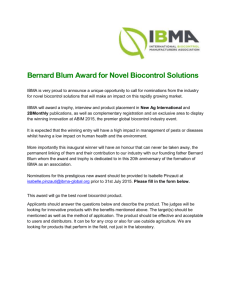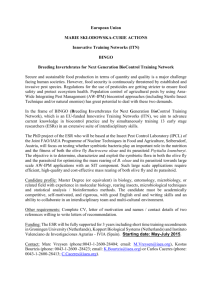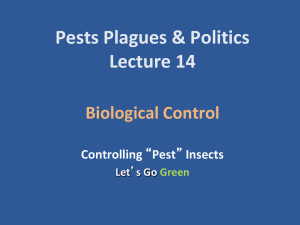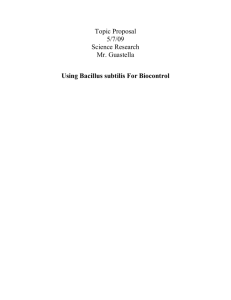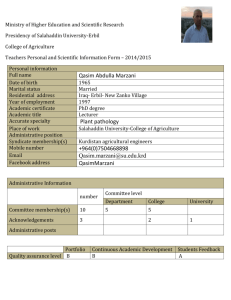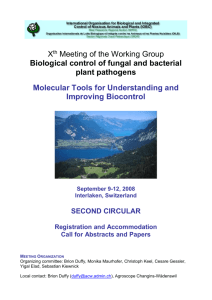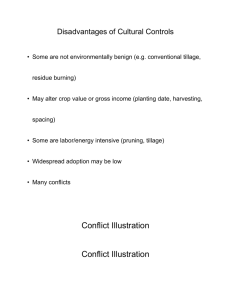DunhamTrimmer Biological Control Market–Jefferies May 10 2015
advertisement
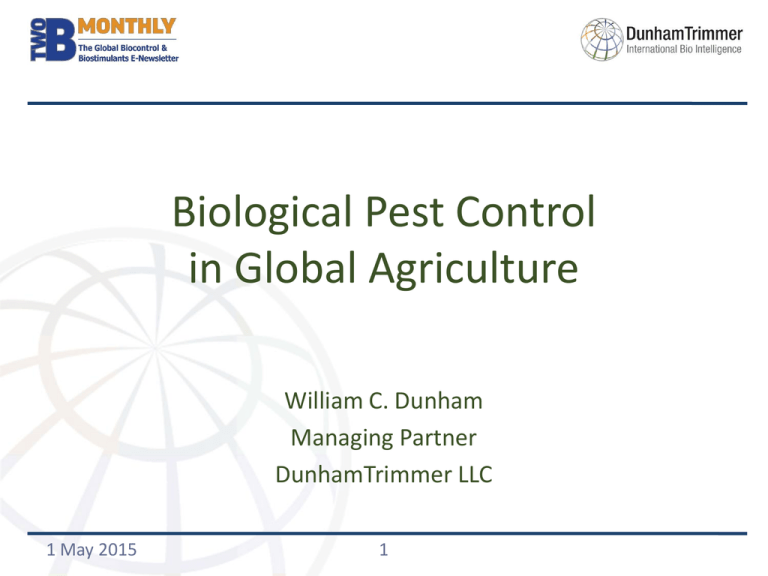
Biological Pest Control in Global Agriculture William C. Dunham Managing Partner DunhamTrimmer LLC 1 May 2015 1 Overview • • • • • • • • • • • Introduction Climate Change Sustainable Agriculture Biological Ag Industries Global Landscape / Stats “Snake Oil” to Science Market Attractiveness 1 May 2015 Market Drivers Multinationals M&A BioControl Companies— Types--Limiters • Case Study—Brazil 2014 • Closing 2 Introduction Personal Background 2007—Founded International Bio Consultants LLC • >35 years in global agri-business • Crop protection-Seeds • AgraQuest, BASF, American Cyanamid, Dekalb Genetics, ICI, Stauffer Chemical • Worked in Argentina-Spain-UK-USA • >10 years in Biological Industries • • • • 2011—Co-Founded DunhamTrimmer LLC 2013—Launched 2BMonthly • The Global Biocontrol & Biostimulant e-Newsletter • Joint effort New Ag Int’l & DunhamTrimmer • Subscribers: Companies, individuals interested in biological industries • Premier Biological Industries Market Research Firm • Clients: Multinational CPC; Bio Companies; Investors; NGO’s • Due Diligence, Multi-client market data, Single client studies 1 May 2015 Global BioControl Industry Global Project Management Launch companies internationally Launch product internationally 3 Climate Change Climate Change Impacts Crops Through: Increased CO2 concentration Higher temperatures Altered, more variable precipitation patterns Extreme weather events will be more common: Heat waves, droughts, freezing, floods……… Timing & location of these events during crop development can greatly influence the impact Source: US EPA 1 May 2015 4 Sustainable Agriculture 70% more food by 2050, using….. Less land Less water Less Fertilizer Fewer pesticides To produce…..? WATER 1 Slice Bread—11 gallons 1 bag Chips—50 gallons 1 Hamburger—630 gallons o 1 Steak—1850 gallons Source: Dr Jack Bobo Sr Advisor for Biotechnology US State Dept 1 May 2015 5 Sustainable Agriculture Companies are striving to meet this opportunity/threat: “We look to innovation as a way to preserve and protect the environment, whether by using energy and resources more wisely (which also helps reduce energy costs), pioneering profitable business and product lines that make use of renewable raw materials or helping customers shrink their environmental footprints.” “We strive to ensure the responsible management of natural resources in order to guarantee access to quality food while ensuring long-term sustainable agricultural, forestry and fishing practices which help to preserve biological diversity..” “We strive to ensure that every step of the McDonald’s supply chain contributes positively to the safety, quality and availability of our final products. We also want our product ingredients to be produced in ways that contribute positively to the development of sustainable agricultural and food manufacturing practices..” “By 2020, we will halve the environmental footprint of our products, help more than 1 billion people take action to improve their health and well-being, and source 100% of our agricultural raw materials sustainably.” Source: 1 May 2015 6 Biological Ag Industries • Biocontrol Control damaging pests • Insects / Diseases / Weeds • Biostimulants Alleviate abiotic stress • Stress from drought, heat/cold, etc • Biofertilizers Enhance nutrient uptake • Nitrogen, phosphate, potassium, others 1 May 2015 7 BIOLOGICAL MARKET OVERVIEW --INTRODUCTION—PRODUCT TYPES Biological Products Biofertilizers BioStimulants Microbials Abiotic Stress Mgmt N Fixing P2O5 Solubiliz ing K Mobilizers Others Amino Acids Microbials Organic Acids Biological Control Products BioPesticides Biochemicals Plant Extracts Seaweed Extracts Biofertilizers Biostimulants • Microbials used to enhance plant nutrient uptake from soil • Nitrogen fixing bacteria make up largest group • Others include mobilizers of specific nutrients (zinc, sulfur) and mycorrhizal fungi • Biofertilizers regulated under country/state fertilizer regulations • Seaweed Extracts make up the largest segment in this group • Microbials, primarily bacteria, often used as seed or soil treatment to aid in nutrient assimilation • Organic acids are humic and fulvic acids used as soil amendments, formed by the microbial degradation of plant matter. • Definition and regulation of biostimulants is still under development in most parts of the world Semiochem Plant Extracts Minerals Microbials Organic Acids Bacteria Fungi Protozoa Virus Insects Mites Nematodes Yeasts Others BioPesticides Macroorganisms • Biopesticides are derived from natural materials, such as plants, bacteria and certain minerals. Biopesticides target specific pests and are inherently less toxic than synthetic pesticides. • Insects; Mites; Nematodes • Insects followed by mites makeup the largest groups • Unique in that the live organism in the form of eggs, larvae, pupae or adult is used. • Most important challenge for Macros is logistics— shipping live organisms that have to have special care to survive • Normally not classified as a Biopesticide—only as Biological Control Products Biochemicals Microbials • Plant Extracts; Minerals & Others; PGRs; Semiochemicals; Organic Acids • Plant Extracts make up the largest segment in this group • Semiochemicals (pheromones) has the largest actual number of products • Largest challenge for Plant Extracts is manufacturing and consistent quality in the active ingredient(s) • Bacteria; Fungi; Virus; Protozoan; Yeasts • Bacteria, followed by Fungi make up the largest groups commercially (>90%) • Microbials are the largest market of biopesticides at US$1.3 Bn. • Biggest challenges for microbials are formulation related: 1) Shelflife; 2) Stability; 3) Performance enhancement Source: DunhamTrimmer LLC 1 May 2015 PGRs Macroorganisms 8 Global Landscape Global BioControl Market Benchmark Values (USD) $US 100 Million 1993 $US 500 Million 1999 2005 2009 $US 250 Million $US 1,000 Million BioControl Market (Bn USD) 5 4 3 2 1 0 1993 1999 2005 2009 2012 2014 2016 2020 Source: BioMarket Database DunhamTrimmer LLC 1 May 2015 $US 3,000 Million $US 1,500 Million 9 2012 2014 $US 2,000 Million 2016 2020 $US 4,000 Million Biocontrol Market Stats 2015 Biocontrol Market 2015 Biopesticide Market Plant Extracts Microorganisms USA/Can Pheromones Lat Am ROW Europe Asia/Pac Macroorganisms 2015 Biopesticide Market BioFungicides BioNematicides BioInsecticides BioHerbicides Others 1 May 2015 10 “Snake Oil” to Science History History • • • • • • • • • • • 400 BC—dried flowers of Tanacetum 17th Century—Nicotine >plum beetle 19th Century–Beauveria >silkworm 19th Century—Mineral & oils 20th Century—Bt insecticide > moths 1920s/30s—France commercial Bt 1950s—Bt Commercial fermentation 1973—First viral insecticide 1977—New Bt strain > flies 1979—EPA 1st pheromone registered 1983—New Bt strain > beetles “Snake Oil” Science • Biological “enthusiasts” • Non-scientific, non-replicated data • Promoted marginal activities • • • • • • “Over Promised—Under Delivered” 1 May 2015 11 Scientific designed replicated trials Scientific data Improved fermentation technology Understanding of “Mode of Action” Deliver on promised results Market Attractiveness New Product Discovery / Development • Synthetic Pesticides Launch Costs == Total Costs $US $150 - 256 Mn* DiscoveryUS$85 Mn • RegulatoryUS$25 Mn Label Launch Biopesticides Launch Costs == Total Costs $US 10-20 Mn (multiple countries $20-$50 Mn.) DiscoveryUS$ 1 Mn • • • • • • • DevelopmentUS$146 Mn Development - US$ 2-3 Mn RegulatoryUS$ 1-2 Mn Label Launch Up to 10 years for registration of a synthetic pesticide from time of discovery Only one out of 139,000 compounds* Development program includes many long term toxicology, environmental fate, and crop residue requirements Much shorter time for a biopesticide approval in USA Discovery shorter – less crowded IP Development requirements less stringent in most countries Return on investment for effective biopesticide products is very attractive *Source: Crop Life America 1 May 2015 12 Bio Market Drivers Manufacturers •Regulatory √ –Lower cost & shorter timeline •Pest Resistance √ –Multiple MOA (Mode of Action) •Portfolio Mgmt Tools √ √ –Full Program Offer •Food Marketers/Consumer Demand –Reduced chemical residues √ √ √ √ √ •Worker safety/flexibility •Sustainability 1 May 2015 Growers 13 Multinationals > $650 Mn +RNAi Assets >$300 Mn >$500 Mn Osage Mftg Plant >$ ?? Mn > $1 Bn >$150 Mn > $ ?? Mn 1 May 2015 14 Acquisitions Acquisitions by "Major Six" CPM Companies Chemical Seed Biopesticides Syngenta 46 19*/5** 3 Bayer 33 24/5 3 BASF 11 2/1 1 Dow 8 17/5 0 Monsanto 0 76 / 12 5 DuPont 3 5/6 1 TOTAL 101 143 / 34 13 50 years 20 years 4 years*** * Acquisitions (direct & indirect) **Partial Ownership *** >$US 2 Bn 1 May 2015 15 BioControl Companies >300 Bio Companies* >200 Biocontrol Companies* >100 Biostimulant Companies* *(outside of India/China) 98% of Bio Companies are Privately Held <5 Biocontrol Companies have > $100 Mn AR 80% of Biocontrol companies have <$10 Mn AR Biocontrol Companies are Found WorldWide Founded by Research individuals Most apparent weakness is Market Access—lack resources Generally lack funding for rapid market growth Crop Protection Market Characteristics “Manufacturers create demand” “Distributors take orders” A typical multinational in US has >300 field personnel A Typical Biocontrol Company in the US has 5-10 field personnel 1 May 2015 16 Case Study-Brazil 2014 Pest – Corn earworm (Helicoverpa armigera) Background • • • Widespread in Old World, first found in Brazil in 2012 Quarantine pest, likely arrived by import Voracious feeder in many crops – corn, cotton, soybeans, many vegetable crops BT crops do not control; no registered insecticides “Perfect Storm” due to continuous cropping & tropical climate 2013 crop losses estimated 5 to 10 billion Real • • • Biocontrol • • • • Regulatory system delays Government approved biocontrol products (baculoviruses) under emergency provisions Biocontrol products are main viable control option available Changing mindset of growers to biocontrol solutions 1 May 2015 Market Growth Biocontrol Market Grew by over $100 Mn in 2014 Growth for the total CPM 17 Closing • Biological Ag Industries – Biocontrol / Biostimulants / Biofertilizers • Green technology / Sustainable technology • More efficient use of resources – Pesticides / Fertilizers / Inputs • Rapidly growing entrepreneurial companies 1 May 2015 18 THANK-YOU FOR YOUR ATTENTION DUNHAMTRIMMER.COM Bill@ or Mark@ DunhamTrimmer.com 1 May 2015 19
